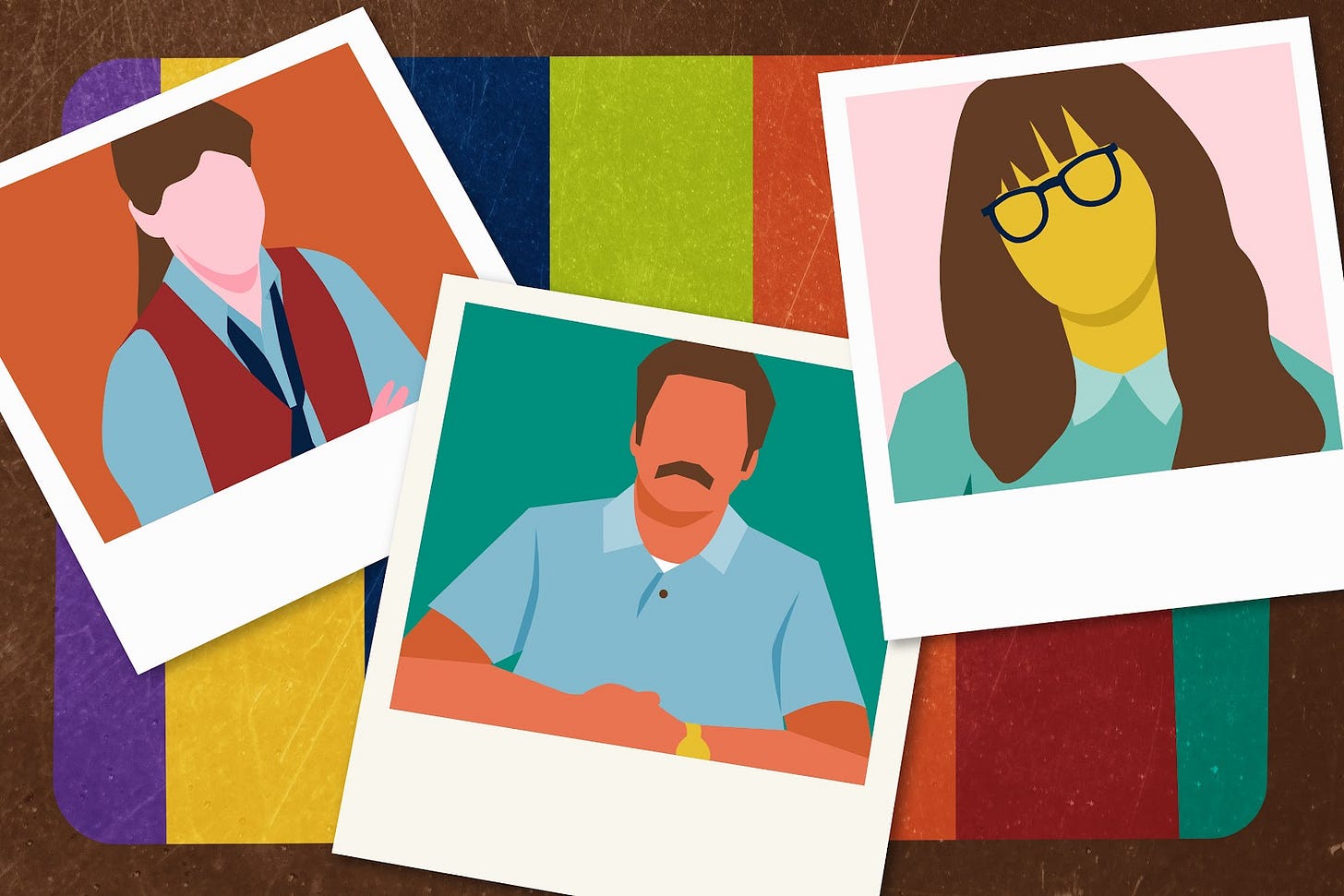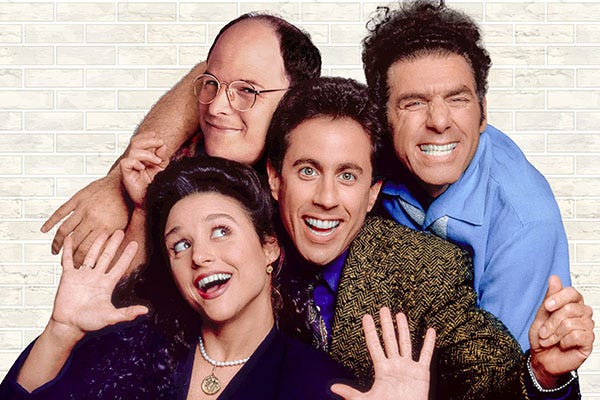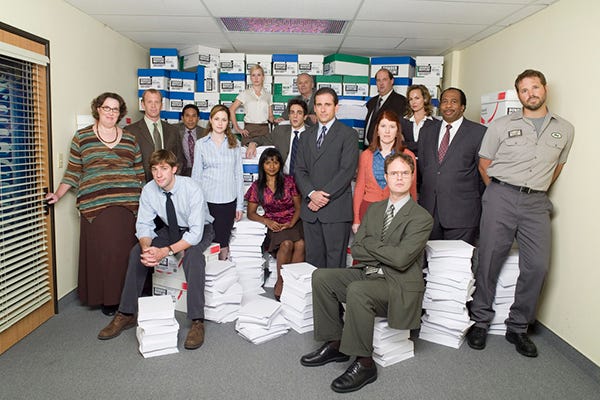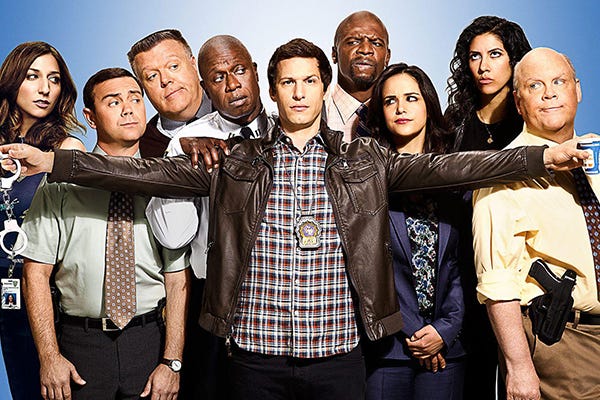The Best Sitcoms From the 80s to Today That We're Still Watching
From laugh tracks to mockumentaries, the evolution of the modern sitcom
The sitcom is a staple of modern entertainment and fandom. Whether you love or hate the format, it’s undeniable that sitcoms are foundational to popular culture. In case you missed it, we took a look at the history of the sitcom from the 1950s through the 1970s. Here we’ll dive right into the newer eras of the sitcom, starting with the 1980s through today.
1980s: Working parents and diverse families
In the 1980s, the sitcom was focused on modern American families that were changing in a dynamic era. The premise of the mega-hit Full House was built on the idea of many parents to help with the rearing of children: When dad Danny Tanner’s wife is killed by a drunk driver, he enlists his brother-in-law and best friend to move in and help out with parenting his three daughters while he maintains his job as a TV host. This new kind of family dynamic upended the idea of the 50s and 60s era sitcom, where Dad goes to work while Mom stays home to keep the house and raise children (though The Wonder Years showcased that kind of nostalgia).
Who’s The Boss? celebrated the typical gender role reversal: working mom Angela Bower (Judith Light) needs a live-in housekeeper to help with her home and look after her son, so she hires Tony Micelli (Tony Danza) to move in with his daughter and do just that. As the title of the show implies, however, they knew they were doing something quite unconventional: showing a man who cooks, cleans, and parents (as the hired help, no less) while the woman of the house works as a high-powered executive with long office hours.
In the 80s, two working parents were common in real life, so it was also common on TV. Hit shows like The Cosby Show and Growing Pains showcased families with two working parents, the premise of each predicated on both parents having notable jobs. In Growing Pains, for instance, Dr. Jason Seavor moves his psychiatrist business into the home because his wife Maggie has gone back to work as a reporter–and someone needs to be home for the kids. And Roseanne featured a working class family where both parents worked in order to make ends meet in suburban Illinois.
Family Ties also featured two working parents, and, like Roseanne, confronted the realities of politics and how they affect family dynamics. In Family Ties, parents Elyse and Steven Keaton are ex-hippies who now work in the arts, and their children are growing up in an 80s cultural revolution: their son Alex (played by Michael J. Fox) is an aspiring successful businessman and Young Republican (in direct contrast to his parents), while his sister Mallory represents 80s-era teenage consumerism. With youngest sister Jennifer often siding with their hippie parents, viewers got to watch this family debate the political issues of the day from several different sides.
In this era, teens and young adults began to have their own identities in sitcoms, and worlds built around their experiences which included diverse friend groups and situations. A Different World was a spinoff of The Cosby Show, and follows one of the Huxtable children to her social circle at a Historically Black College. In Diff’rent Strokes, two Black orphaned children from Harlem (played by Gary Coleman and Todd Bridges) are taken in by a wealthy white Park Avenue businessman and his young daughter Kimberly. The series focused on teen-centered issues of the time, but also adjustment issues that adopted children face as well as racism and culture clashes. The Facts of Life, a spinoff of the show featuring Kimberly’s move to a boarding school–along with their housekeeper–is similarly focused on issues affecting teen girls as well as culture clashes, as the cast of characters is also diverse.
Diversity in comedy stretched in other ways too: The Golden Girls features four main characters in their “golden” years, still dating, working, and living together like teenage roommates. And Cheers, the ultimate workplace sitcom, takes place almost entirely within the four walls of a Boston bar, where people from all walks of life can be seen and mingle together at any time of day.
1990s: Comedians, teens and singles rule prime time
You can’t think about 90s sitcoms without thinking about stand-up comics. Comedian Jerry Seinfeld didn’t need a premise for a sitcom; he only needed to showcase his observational comedy which was, arguably, about nothing. But as his show, Seinfeld, became more and more popular, it was clear that a show about nothing in particular but the mundanity of life could be extremely funny. Mad About You, led by comedian Paul Reiser, featured newlyweds just trying to figure out their new lives together. Ellen (formerly These Friends of Mine) was the vehicle for stand up comedian Ellen Degeneres. Stand-up Ray Romano tackled highly relatable in-law struggles in Everybody Loves Raymond.
Home Improvement, led by comedian Tim Allen, not only relied on his comedic legacy as a stand-up for viewership, but featured three young boys as his sons that would become this generation’s teen heartthrobs. Programming aimed at young teens and families was increasingly popular–especially with programming blocks like TGIF on ABC–and more shows featured tweens and teens in starring roles like Doogie Howser, M.D., Blossom, Boy Meets World, The Fresh Prince of Bel-Air, Step By Step and Sister, Sister. These shows all showcased, first and foremost, the struggles of being young. Whether doing rounds as a medical doctor at sixteen, moving in with your wealthy aunt and uncle from a poor town where you were constantly getting into trouble, or finding your long lost twin at a mall, these shows all put young characters into the leading roles.
In the 90s, as modern young adults were having families of their own later in life, sitcoms celebrated the single, childless, young adult lifestyle as well. Living Single, a show about six friends living single lives in Brooklyn with an all Black cast, featured stories about dating, working, and friendship. The hit show Friends would follow the same model, placing its all white cast in the West Village of NYC. Frasier, a spinoff of Cheers, followed the single life of Dr. Frasier Crane who, having both the room in his Seattle apartment and no children to tend to, allows his aging father to move in.
2000s: Mockumentaries and modern families
In the 2000s, sitcoms got an upgrade: While some shows from the 90s were still on the air, new sitcoms offered updated formats and thoughtful wit over canned laugh tracks. Shows like Scrubs combined the slapstick comedy found in older sitcoms with the often touching internal monologue of its main character J.D., (played by Zach Braff) as well as surreal fantasies that play out on screen. Malcolm in the Middle had no laugh track, but middle child Malcolm breaks the fourth wall consistently to speak directly to the audience. Everybody Hates Chris, a sitcom loosely based on comedian Chris Rock’s life as a kid, is narrated in voiceover by the comedian himself. And speaking of narration, How I Met Your Mother introduced a brand new concept: a narrator telling his kids about the story of how he met their mother–which plays out in the present day over nine seasons.
Speaking directly to camera was more and more common with the introduction of mockumentary style comedies. The Office (based on the British show of the same name) is a mockumentary style show where unseen filmmakers document the goings-on at a branch office of a regional paper company. Their cameras catch every ridiculous idea that manager Michael Scott suggests, as well as the interpersonal relationships of the office mates that might not otherwise be seen, and this is where the storytelling is full of depth and heart as well as lots of laughs.
Over the top comedy wasn’t limited to mockumentaries. Curb Your Enthusiasm stars Larry David as an exaggerated version of himself in a heightened reality where simple day-to-day occurrences explode into catastrophic events, always with a nod to the audience that this reality is very much based on the one we know. The same could be said of 30 Rock, Tina Fey’s comedy about a live sketch comedy show filmed at 30 Rockefeller Plaza, similar to Saturday Night Live. The show consistently mocks the NBC network’s corporate structure as well as its programming inside the dialogue, inviting viewers to make fun of the corporate machine that is network TV. The situations are a bit absurd and that’s what makes this comedy inside a very real world unique.
Absurdity and bad behavior abounds in sitcoms of this era. in It’s Always Sunny in Philadelphia–a phenomenon as it is the longest running sitcom in history–the downright sociopathic cast of characters are what viewers love about the series. And Arrested Development’s highly dysfunctional Bluth family gained the series a cult following as well as praise from critics.
Still, the traditional laugh track sitcom succeeded. Two and a Half Men was immensely popular as it starred 80s and 90s superstars Jon Cryer and Charlie Sheen, That 70s Show launched the careers of several young actors in blending nostalgia with wit, and the Big Bang Theory struck a deeply funny chord at the axis of science and comedy.
The George Lopez Show, starring comedian George Lopez, helped expand representation on screen with an all Latino cast. Actress Sandra Bullock sought out the comedian and was integral to the development of his sitcom, which she executive produced, specifically because she felt there was very little Latino representation on TV at the time.
In this era, both Nickelodeon and Disney Channel exploded in teen and tween sitcoms, notably Lizzie McGuire, Hannah Montana, Sonny With a Chance, That’s So Raven, Drake & Josh, Suite Life of Zack and Cody, Wizards of Waverly Place, and Even Stevens–among others.
2010s through today: Loveable misfits and diverse casts
The mockumentary style only got better in the 2010s. Parks & Recreation takes the office mockumentary to local city government in fictional Pawnee, Indiana. Amy Poehler’s Leslie Knope is the ambitious deputy director of Parks and Recreation hell bent on improving the lives of her community members. Veep also draws on government for comedy as a mockumentary about the self-involved Vice President of the United States Selina Meyers, played by Julia Louis Dreyfus.
The gargantuan hit Modern Family took the mockumentary style inside the homes of three nuclear families within an extended one, showcasing their very normal day to day activities as well as numerous hijinks. Modern Family also made waves in another significant way, by presenting diverse characters and a variety of different family relationships including a gay couple looking to adopt and a love connection between two characters with a huge age gap after divorce.
Quirky comedies featuring offbeat loveable misfits dominated the air with shows like Community, New Girl, Cougar Town, Brooklyn Nine-Nine and Happy Endings, ensemble sitcoms without laugh tracks that celebrate individual neuroses and outrageous situations that viewers couldn’t help but find relatable and hilarious. And cable sitcoms like Broad City and Silicon Valley, also featuring characters with questionable motives played for comedy, took subversion to new levels.
Following the lead of The George Lopez Show, representation of diverse families continued. Fresh Off the Boat is a critically acclaimed sitcom featuring a Taiwanese-American family who relocate from Washington, D.C.’s Chinatown to Orlando, FL in the 1990s. They struggle to balance assimilation with maintaining their cultural identity, and the combination is great fodder for relatable comedy. Similarly, Black-ish, a comedy about a wealthy Black family who struggles to balance maintaining their Black cultural identities while living in a white affluent neighborhood. It garnered immense critical acclaim and turned lead actors Anthony Anderson and Tracee Ellis Ross into household names. Both comedies highlight the complexities involved in raising children who are growing up in a different, more progressive cultural reality than their parents.
The most recent sitcoms in the 2020s are taking the format far and wide into new and interesting storytelling, especially with streaming platforms making a variety of shows to choose from possible. Ghosts is a sitcom about the, well, ghosts that inhabit a newlywed couple’s new home–and the wife can see them all. They just don’t want to be kicked out of their final resting place, so the living and the dead hilariously coexist together. Girls5Eva follows the four remaining members of a 2000s era girl group on their new musical endeavors, and mixes high comedy with incredible singing talent as it stars Sara Bareilles, Renee Elise-Goldsberry, Busy Philipps and Paula Pell. Abbott Elementary blends comedy with the very real concerns of modern teachers and systemic socio-economic issues that affect inner cities. Hacks is a spin on the mismatched buddy comedy trope, combining the tension that arises between younger and older generations with a deep dive into what is and what isn’t funny depending on your perspective.
Whatever your interest, it’s possible to find a sitcom for you in the modern landscape of storytelling that suits you. But even if you can’t, because we live in an age of streaming content, you can likely very easily find that sitcom you loved twenty years ago right at your fingertips. Tell us in the comments which sitcoms have been your favorites over the years!
Want more? Our Discord is where you’ll find tons of other fans there chatting in our forums about the books, TV shows, movies, music, and games we all love! Don’t forget to follow us on Instagram, tumblr, and Spotify for more fandom content—and hit that subscribe button so you never miss a thing at rmrk*st!








